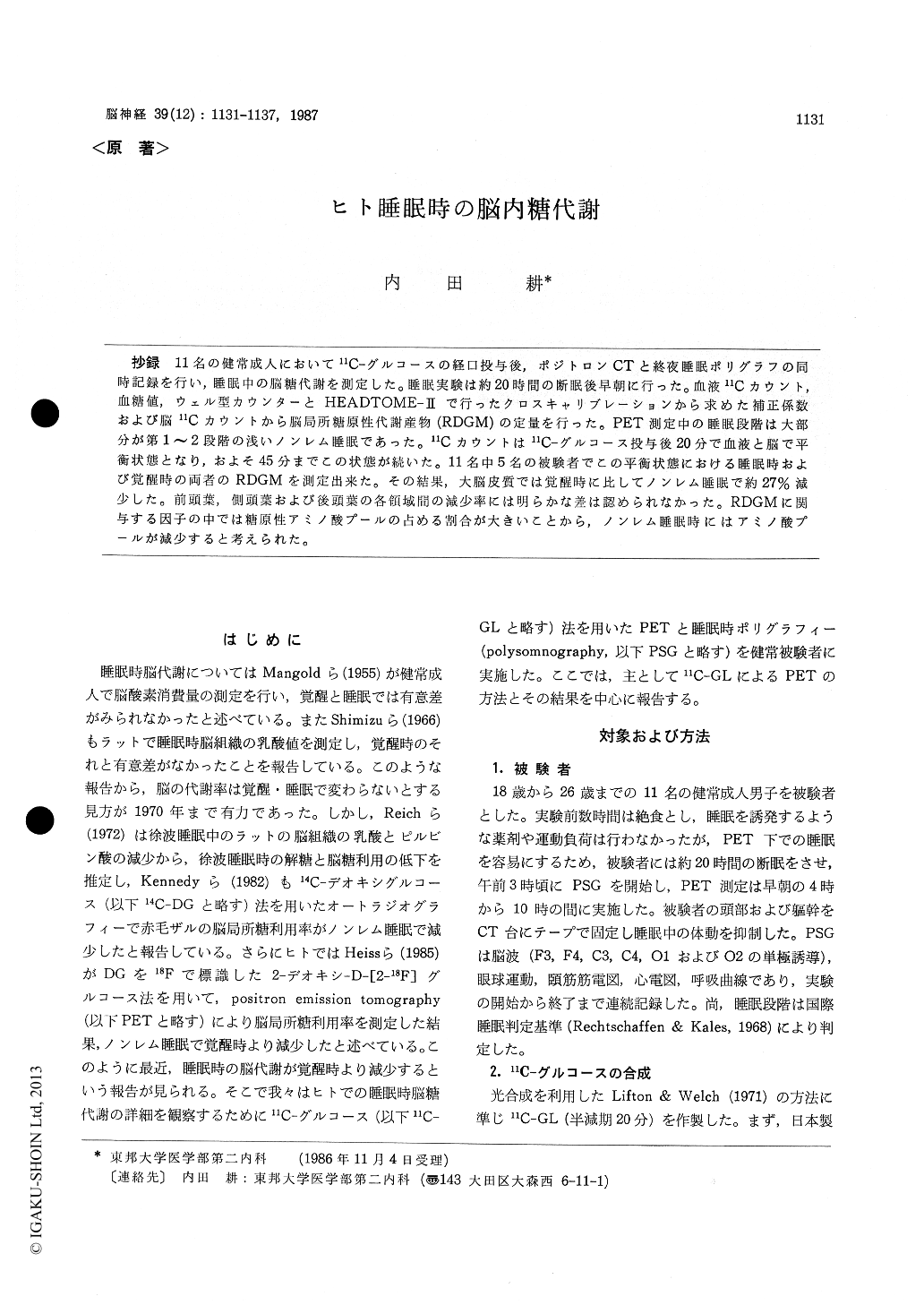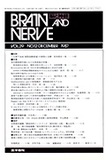Japanese
English
- 有料閲覧
- Abstract 文献概要
- 1ページ目 Look Inside
抄録 11名の健常成人において11C—グルコースの経口投与後,ポジトロンCTと終夜睡眠ポリグラフの同時記録を行い,睡眠中の脳糖代謝を測定した。睡眠実験は約20時間の断眠後早朝に行った。血液11Cカウント,血糖値,ウェル型カウンターとHEADTOME-IIで行ったクロスキャリブレーションから求めた補正係数および脳11Cカウントから脳局所糖原性代謝産物(RDGM)の定量を行った。PET測定中の睡眠段階は大部分が第1〜2段階の浅いノンレム睡眠であった。11Cカウントは11C-グルコース投与後20分で血液と脳で平衡状態となり,およそ45分までこの状態が続いた。11名中5名の被験者でこの平衡状態における睡眠時および覚醒時の両者のRDGMを測定出来た。その結果,大脳皮質では覚醒時に比してノンレム睡眠で約27%減少した。前頭葉,側頭葉および後頭葉の各領域間の減少率には明らかな差は認められなかった。RDGMに関与する因子の中では糖原性アミノ酸プールの占める割合が大きいことから,ノンレム睡眠時にはアミノ酸プールが減少すると考えられた。
Some reports have suggested that there is no difference in cerebral metabolic rates between wakefulness and sleep. However recently Kennedy et al. and Heiss et al. reported a decrease incerebral glucose utilization during NREM sleep measured by the using deoxyglucose method. We used a 11C-glucose method for positron emission tomography (PET) while estimating cerebral glucose metabolism during human sleep with polysomnography (PSG). This PET and PSG study was carried out on 11 healthy male volun-teers ranging in age from 18 to 26 years. In order to facilitate the onset of sleep, the subjects were deprived of sleep, under observation in the lab, for a period of approximately 20 hours prior to the PSG and PET examination. All experiments were performed in the early morning, most often between 4 and 10 AM. The subjects' sleep was monitored by PSG, i. e. electroencephalogram, electrooculogram and a submental electromyogram. The 11C-glucose used in the experiment was prepared by the biosynthetic method developed by Lifton and Welch, using 11C produced by a baby cyclotron. The 11C-glucose solution, con-taining about 20 mCi of 11C activity was admi-nistered orally to the subjects. The time course of the 11C activity in the blood following the administration was determined by drawing 1 ml of blood from the antecubital vein once every 10 minutes. These samples were assayed for 1111Cactivity in a NaI well counter. The PET images of a horizontal cross-section of the brain at 45mm above the orbito-meatal line, were used for the analysis of the glucose metabolism. The region of interest was set on the superior frontal and superior temporal gyri, and on the occipital lobe in the PET imaging. Regional distribution of glycogenic metabolites (RDGM) was measured for the analysis of cerebral glucose metabolism. TheRDGM (mg/100 g brain) was calculated using the following formula : RDGM = SE × PG/CG × K SE is the pixel count in the PET image, CG is the mean 11C radioactivity in the blood, PG is the plasma glucose level, and K is the calibration factor which was derived from the cross-calibra-tion between the PET count and the NaI well counter. PET scannings were carried out mostly during light NREM sleep, i. e. stage 1 and/or 2, and wakefulness. About 20 minutes after the 11C-glucose administration, the 11C activity of the blood and brain were equilibrated with each other and this equilibrium was maintained for 25 minutes. During the period of equilibrium, the RDGM was calculated. We were able to measure the RDGM during both wakefulness and NREM sleep in 5 of 11 subjects. The RDGM of frontal, temporal and occipital cortices during wakefulness were 162.0 ± 27.9,165. 0-±34.9 and 157.0 ± 18.4 mg/100 g brain tissue, respectively. On the other hand, they were 117. 6 -±19. 0, 119. 5 -±25. 4 and 117.3 -±14.0 mg/100g brain tissue during NREM sleep. Among the three cortices, the RDGM dur-ing NREM sleep exhibited about a 27% decrease from the level found during wakefulness. The RDGM is influenced by several factors such as 11CO2, tricarboxylic acid cycle intermediates, pyruvate, lactate, glucose and the metabolic pool of amino acids. According to the rat study by Soeda et al., of the above factors the metabolic pool of amino acids accounted for more than 60% of RDGM. Thus a decrease in RDGM suggests a decrease in the metabolic pool of amino acids during NREM sleep.

Copyright © 1987, Igaku-Shoin Ltd. All rights reserved.


